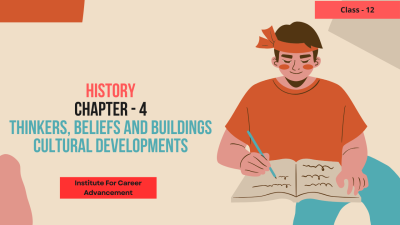Thinkers, Beliefs and Buildings Cultural Developments - Class 12

₹299
Thinkers, Beliefs, and Buildings: Cultural Developments is a Class 12 chapter that likely explores the intellectual, religious, and artistic aspects of ancient civilizations. It might delve into topics such as: Philosophical and Religious Thought: The ideas and beliefs of prominent thinkers and philosophers, the development of major religions, and the impact of these beliefs on society. Architectural Marvels: The construction techniques, purpose, and significance of iconic buildings and structures in ancient civilizations. Artistic Expressions: The different forms of art, such as painting, sculpture, and literature, and their cultural significance. Scientific Discoveries: The contributions of ancient civilizations to fields like astronomy, mathematics, and medicine. Cultural Exchange and Diffusion: The ways in which ideas, beliefs, and practices were shared and adopted by different civilizations. Overall, this chapter likely provides a comprehensive overview of the cultural achievements of ancient civilizations, setting the stage for understanding the subsequent development of art, philosophy, religion, and science. চিন্তাবিদ, বিশ্বাস এবং ভবনঃ সাংস্কৃতিক উন্নয়ন হল দ্বাদশ শ্রেণির একটি অধ্যায় যা সম্ভবত প্রাচীন সভ্যতার বুদ্ধিবৃত্তিক, ধর্মীয় এবং শৈল্পিক দিকগুলি অন্বেষণ করে। এটি নিম্নলিখিত বিষয়গুলি নিয়ে আলোচনা করতে পারেঃ দার্শনিক ও ধর্মীয় চিন্তাঃ বিশিষ্ট চিন্তাবিদ ও দার্শনিকদের ধারণা ও বিশ্বাস, প্রধান ধর্মগুলির বিকাশ এবং সমাজে এই বিশ্বাসগুলির প্রভাব। আর্কিটেকচারাল মার্ভেলসঃ প্রাচীন সভ্যতায় আইকনিক বিল্ডিং এবং কাঠামোর নির্মাণ কৌশল, উদ্দেশ্য এবং তাৎপর্য। শৈল্পিক অভিব্যক্তিঃ শিল্পের বিভিন্ন রূপ, যেমন চিত্রকলা, ভাস্কর্য এবং সাহিত্য এবং তাদের সাংস্কৃতিক তাৎপর্য। বৈজ্ঞানিক আবিষ্কারঃ জ্যোতির্বিজ্ঞান, গণিত এবং ওষুধের মতো ক্ষেত্রে প্রাচীন সভ্যতার অবদান। সাংস্কৃতিক বিনিময় এবং বিস্তারঃ বিভিন্ন সভ্যতার মধ্যে ধারণাগুলি, বিশ্বাস এবং অনুশীলনগুলি ভাগ করে নেওয়ার এবং গ্রহণ করার উপায়গুলি। সামগ্রিকভাবে, এই অধ্যায়টি সম্ভবত প্রাচীন সভ্যতার সাংস্কৃতিক সাফল্যের একটি বিস্তৃত বিবরণ প্রদান করে, যা শিল্প, দর্শন, ধর্ম এবং বিজ্ঞানের পরবর্তী বিকাশ বোঝার জন্য মঞ্চ তৈরি করে।
Learn more
 0
0 